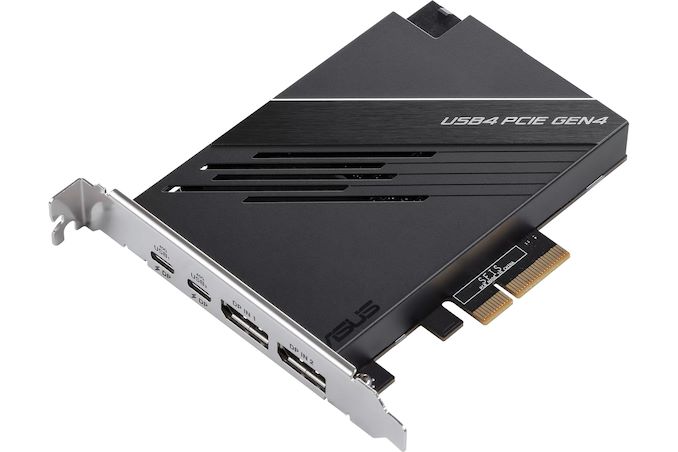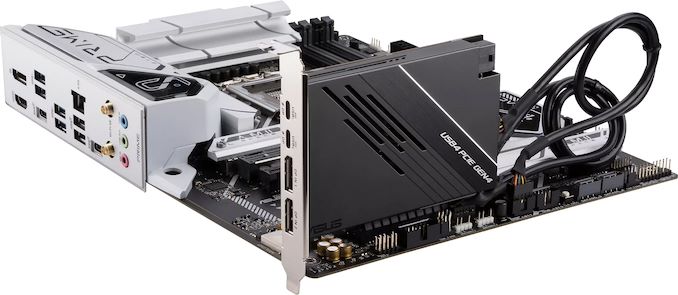Asus Launches USB4 Add-In-Card: Two 40 Gbps Ports for Desktops
by Anton Shilov on January 24, 2024 9:00 AM EST- Posted in
- Motherboards
- Asus
- USB4

Asus has introduced a USB4 PCIe add-in-card for the company's desktop motherboards, allowing users to add two USB4 ports to their systems. The card can be used to connect up to four devices and a display to each of its ports, and can even be used to charge laptops that support USB charging.
The Asus USB4 PCIe Gen4 Card is based on ASMedia's ASM4242 controller and supports two USB4 ports at 40 Gbps data rates, with up to 60W USB Power Delivery. The board also has two DisplayPort inputs to in order to route graphics through the card as well in order to make full use of the versatility offered by USB4 and the Type-C cable. Alternatively, one can connect the card to the motherboard TB3/TB4 header and use integrated GPU to handle displays connected using USB-C cables.
One of the main advantages that the ports of Asus USB4 PCIe Gen4 card have over USB4 ports found on some motherboards is that it supports 60W Quick Charge 4+ to devices, which enables to charge laptops or connect devices that demand more than 15W of power (but less than 60W).
There is a catch about the Asus USB4 PCIe Gen4 card though: it is only compatible with Asus motherboards and needs a motherboard with a Thunderbolt or USB4 header (which is mostly designed to use integrated GPU). The company says that many of its AM5 and Intel 700-based motherboards have an appropriate header, so the device can be used on most of its current-generation boards.
The card operates on a PCIe 4.0 x4 interface, providing 7.877 GB/s of bandwidth to the ASMedia controller. The card also features a six-pin auxiliary PCIe connector to supply the additional power needed for the card's high-powered ports.
Asus has yet to reveal recommended price and availability date of its USB4 expansion card. Given that this is not the industry's first card of this kind, expect it to be competitively priced in comparison to existing Thunderbolt 3/4 expansion cards, which have been on the market for a while.
Source: Asus












22 Comments
View All Comments
mukiex - Wednesday, January 24, 2024 - link
I always thought the insane Thunderbolt pricing was due to the Intel monopoly but nowadays I wonder if the technology is just inherently a non-starter due to the price of tunneling everything, akin to those optical USB cables that never really dip under a few hundred dollars.Samus - Wednesday, January 24, 2024 - link
It's just a way to milk business customers, content producers and HEDT users. TB does not inherently cost a lot to implement. My reference example is the BOM for an HP Probook 440 G9 and Elitebook 640 G9 - previously classed as a Probook 640, is a $20 difference. The only difference between the two is the 640 has Thunderbolt and the 440 does not. They are literally identical except for a provision made to the identical motherboard for the TB controller, and badging. This isn't some trade secret; you can spec out the components on parts.hp.comBut as built, TB-equipped PC's demand a huge premium, possibly driven by demand, but in my opinion, driven by greed.
meacupla - Wednesday, January 24, 2024 - link
Yeah, TB3/4 is not an expensive feature with Intel laptops.I assume the majority discount happens when ordered with a mobile CPU.
The minor BoM savings would come from shorter traces on the mobo.
Jorgp2 - Thursday, January 25, 2024 - link
How could it be due to the intel monopoly if Intel wasn't the one making the end products in the first place?They actually made it cheaper by including it into the CPU.
The prices are most likely due to OEMs marketing it as a premium feature, regardless of how much it costs to implement.
Samus - Friday, January 26, 2024 - link
Exactly. It's all marketing. The motherboards are virtually identical between processors. All I can guess is the USB-C traces are hardened or something, maybe some shielding, and obviously a different firmware. The whole thing is ridiculous and a clear play to hit AMD in the mobile space. Docking a Ryzen laptop is not a trivial matter and most people accept the DP-over-USB function and the limitations that go with it.saratoga4 - Thursday, February 8, 2024 - link
3rd party controllers are just starting to hit the market in volume, so prices are still somewhat inflated after the long period when you could only buy from Intel at Intel prices. We'll hopefully see more widely available support as more vendors offer a wider range of controllers at different (and hopefully more competitive) price points.erotomania - Wednesday, January 24, 2024 - link
So one internal cable is for USB header, and the other is for...Thunderbolt header? Additional power? Sure doesn't help out the look of a clean build, but internal cards rarely do.ballsystemlord - Wednesday, January 24, 2024 - link
"Only compatible with ASUS motherboards"... That's quite the gotcha.Plus you can draw 75W of power through the PCIe connector, yet this AIC requires a PCIe 6 pin connection for outputting 60 total watts. Or was it mistyped, and you can draw 60W per USB port?
Ryan Smith - Thursday, January 25, 2024 - link
PCIe spec is only 25W for a x4 card. Technically, you could probably get away with it on some better boards. But if you're sticking to spec, external power is needed for this card.ballsystemlord - Thursday, January 25, 2024 - link
Ah, I'm an x16 slot. Thanks, I didn't know that power draw capabilities varied between slot sizes.